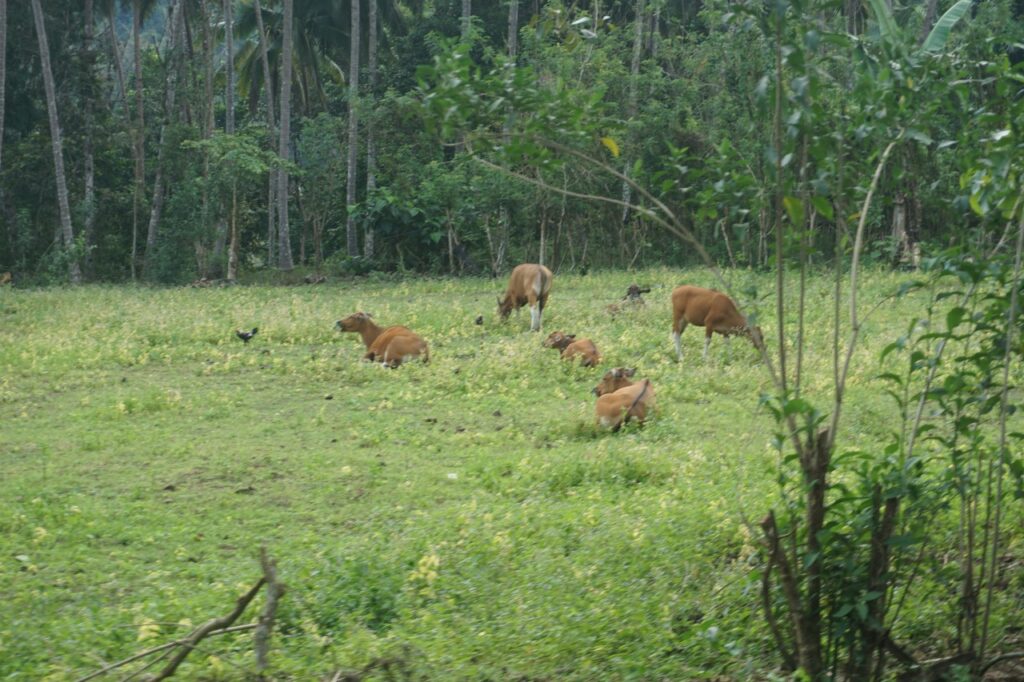Every dawn in Kaluppini Village, the village atmosphere begins to come alive with a rhythm that has been ingrained for centuries in the local indigenous community. Behind the green hills and expanses of rice fields, the crowing of roosters can be heard echoing, as if inviting the indigenous community to start the day. They start their activities by cleaning the pens, while the cows that are the pride of the family are herded towards the pastures rich in fresh feed. Here, raising livestock is not just an economic activity, but a symbol of harmony between humans and nature.
In Kaluppini, livestock farming has become an integral part of life. indigenous peoples. This tradition is passed down from generation to generation, reflecting a way of life that is in harmony with nature. The method of tethering livestock near the location of grass feed is one form of local wisdom that is still maintained until now. Choosing the right location to tether livestock, usually in grasslands or forest edges, not only takes into account the needs of livestock feed, but also the balance of the ecosystem.
Initially, indigenous people let their livestock roam freely in the forest. However, over time, the need for more orderly management led to the birth of village regulations governing the tethering of livestock. These regulations are not only to maintain order, but also to protect agricultural land and residents' property from damage. With these regulations, livestock are tethered in designated areas, allowing owners to supervise and ensure that their livestock get enough food without damaging the surrounding environment.
The process of tethering cattle is more than just a daily routine. It reflects the Kaluppini indigenous people’s deep knowledge of the cycles of nature. By tethering cattle in different locations on a rotating basis, they prevent the land from overgrazing, which can damage its fertility. This knowledge shows how deep their understanding of nature and the environment is, which has been passed down from generation to generation.
Moreover, this tradition also contains important social values.
Tethering involves the entire family, from children to adults. Each family member has a role, creating togetherness and a strong bond between them. Values such as responsibility and caring for nature are also taught through this activity, making it an integral part of family education in Kaluppini.
However, like many other traditions, farming in Kaluppini is not free from challenges. Climate change, for example, has affected the availability of natural food. The threat of urbanization is also beginning to be felt, disrupting the harmony that has been maintained so far. However, the Kaluppini indigenous people are not standing still. They are starting to adapt their traditional practices with modern approaches, which allow them to remain relevant amidst changing times.
One example is by combining traditional feed with modern, scientifically formulated feed, such as silage. Silage not only provides more balanced nutrition, but can also be stored longer, especially in the dry season. In addition, the use of modern technology in livestock health management, such as vaccination and regular check-ups by veterinarians, helps prevent and treat more serious diseases. With this approach, the Kaluppini indigenous people not only maintain their traditions, but also increase the productivity of their livestock.
Support from various parties is also very necessary to maintain the sustainability of the livestock farming tradition in Kaluppini. The government, for example, has provided technical training and provided affordable animal health facilities. Non-governmental organizations and academics also play an important role by providing education and research that helps farmers optimize their practices. In addition, support from local communities and the private sector, such as companies that provide access to wider markets, is also key to maintaining the sustainability of this tradition.
The initiative to develop sustainable livestock farming in Kaluppini Village provides new hope. The combination of local wisdom and modern technology not only helps increase livestock productivity but also preserves the environment. The younger generation in Kaluppini is also encouraged to preserve this tradition, making it an important part of their cultural identity.
Farming in Kaluppini is not just an economic activity, but a symbol of the harmonious relationship between humans and nature. With the right support and wise adaptation, this tradition will continue to be a vital part of the life of the Kaluppini indigenous people, and a legacy that will continue to live and thrive in the future.


